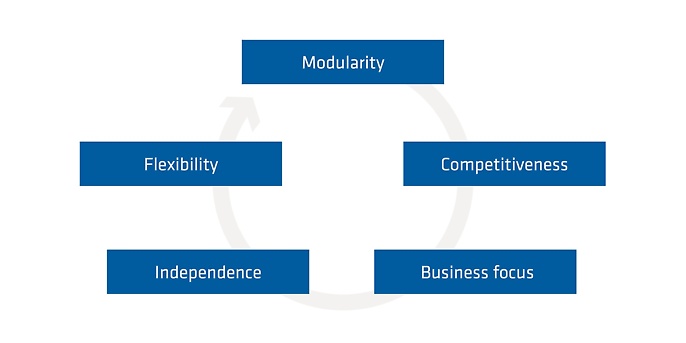13. June 2022 By Laura Schöning
Composable commerce for greater agility and investment security
During the Covid pandemic, shopping patterns changed a lot. Due to lockdowns and temporary closures of brick-and-mortar shops, the focus of consumers has shifted to the digital world, bringing strong growth for online retailers.
However, this is both a blessing and a curse for the companies. In financial terms, growth in online sales is undoubtedly positive and represents an effective way to leverage digitalisation in the online retail space. Conversely, this shift is both extraordinary and unpredictable in the scale in which it occurred and comes with a number of major challenges. Shop owners are forced to react to these changes as quickly as possible in order to meet the ever-increasing demands of customers. However, this cannot be done at the required scale with the existing architectural concepts used by most shop systems, which are often rigid and inflexible.
What is the common definition of ‘composable commerce’?
The term was first coined in 2020 by the US market research and consulting company Gartner Inc. But what exactly does it mean? Composable commerce is an IT infrastructure in which some but not all business applications are covered by a single system. Instead, a set of well-suited software for digital commerce is purchased using any number of modules to create a custom application.
In this context, one is almost certain to come across the term ‘packaged business capabilities’, or PBCs for short. Packaged business capabilities are part of the composable commerce strategy, and they are used to create a best-of-breed commerce solution. Gartner describes them as software components that represent a well-defined business capability, functionally recognisable as such by a business user.
The takeaway: composable commerce is about combining the best technologies to obtain an application that fits a company’s need perfectly.
And why should companies opt for composable commerce?
Composable commerce vs. an all-in-one solution
Customer requirements have become more complex and demanding. It is therefore highly unlikely to find an all-in-one application that can fully meet their needs in the long term.
The composable commerce strategy allows you to meet the demands of tomorrow. The following bullet points illustrate why you should opt for this approach in order to become agile and ready for what the future will bring.

1. Modular
Each component is a standalone system that can be provisioned and swapped out without affecting the other components. This modular approach enables greater agility, faster time-to-market and improved customer experience across all devices and touchpoints. The open ecosystem offers the possibility to integrate and link third-party providers and best-of-breed solutions.
2. Flexibility
Components can be exchanged thanks to modern, flexible technologies and a headless architecture based on the API-first principle. This unique setup enables users to create individual commerce experiences tailored to the needs of customers.
3. Competitiveness and differentiation
All channels and touchpoints can be used, allowing the retailer to utilise its full sales potential.
It also provides the flexibility and agility needed to react quickly to new market and customer demands and gain an edge on one’s competitors.
4. Focus on business
The flexible system landscape enables companies to react to new market demands and developments quickly and at little cost to them in order to increase their innovation potential. New strategies and business models can be implemented with ease without being slowed down by outdated IT structures. Use of state-of-the-art technologies also increases work efficiency.
5. Independence
This approach gives you the independence you need since you are not reliant on any one provider. You are able to control the features and performance delivered by your solution.
Why is the future of business ‘composable’?
The main advantage of composable commerce is the possibility to perfectly adapt the company’s commerce setup to meet its specific requirements.
When applying this approach, only the components and functions that are really needed are used. Of all the applications available on the market, the company is able to select precisely the ones that are most suitable for the task. Whereas with an all-in-one solution, one has to make do with the very limited basic functions it offers.
Breaking down boundaries
Limits imposed by your company’s system landscape are broken down, and you retain control over the features and performance offered by your solution.
Composable commerce focuses on what makes a company unique and sets it apart. The entire e-commerce tech stack becomes faster, streamlined, more flexible and easier to maintain as a result. Building on this, the ideal customer experience can be created for customers across all touchpoints.
Conclusion
With or without pineapple? What do composable commerce and the perfect pizza have in common?
On a metaphorical level, this approach is quite similar to how one goes about making the perfect pizza. In our example, PBCs are to composable commerce what the individual ingredients are to a pizza. To achieve the best overall results, you need to take great care in selecting only the high-quality ingredients that go well together. Opinions can vary widely on what makes for a perfect pizza, which ingredients are absolutely necessary and which ones are to be avoided. The combination of ingredients can therefore be tailored to meet your personal taste. If you’ve ever enjoyed the perfect slice of pizza, you will probably never again settle for one from the frozen food aisle at the local supermarket. On a similar vein, a company would not choose an all-in-one solution after discovering the virtues of composable commerce.
Remaining competitive by rethinking IT structures
A single platform that delivers all the key functions would at first glance appear incredibly practical. Perhaps it could even meet the as yet simple requirements of consumers – at least for a certain amount of time. In times like these, however, the bar in e-commerce is much higher in both the B2C and B2B sectors. If you opt for an all-in-one solution, however, you will quickly reach the limits of what is possible. Monolithic systems do not offer the flexibility and agility needed to meet customer expectations.
Would you like to learn more about other exciting topics from the world of adesso? Then check out our latest blog posts.
Why not check out some of our other interesting blog posts?

